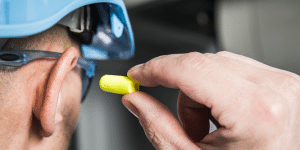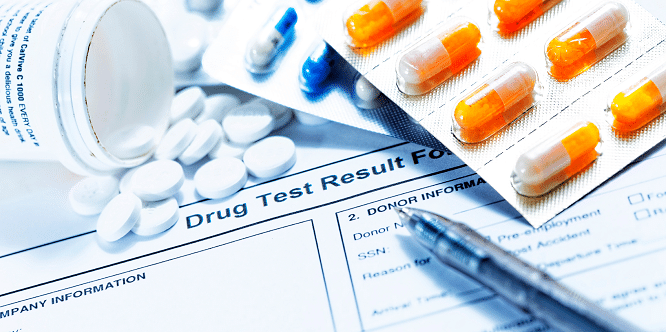This information is provided for educational purposes only. The reader retains full responsibility for the use of the information contained herein.
A drug test is a technical analysis of a biological specimen to determine the presence or absence of specified parent drugs or their metabolites. Drug testing does not determine impairment or current drug use. Rather, it determines if a specified amount of a drug or its metabolite is in the specimen. The U.S. Department of Transportation (DOT) regulations and various state drug testing laws specifically identify the substances and cut-off levels that employers must incorporate into their testing program. Non-DOT-regulated employers or employers in states without drug testing laws may choose both the drug panel and the drug cut-off levels to best fit their company needs.
For instance, the DOT requires testing to be conducted according to SAMHSA guidelines, which mandate the five illicit drugs outlined below:
• Amphetamines (meth, speed, crank, MDMA/MDA)
• THC (cannabinoids, marijuana, hash)
• Cocaine (coke, crack)
• Opiates (heroin, codeine, morphine, hydrocodone/hydromorphone, oxycodone/oxymorphone)
• Phencyclidine (PCP, angel dust)
This SAMHSA-regulated test is commonly referred to as a 5-panel drug test. In addition, the guidelines specify the following drug cut-off levels for the primary substances:
| Amphetamines | Initial: 500 ng/mL | Confirmatory: 250 ng/mL |
| THC | Initial: 50 ng/ mL | Confirmatory: 15 ng/mL |
| Cocaine | Initial: 150 ng/ mL | Confirmatory: 100 ng/mL |
| Opiates | Initial: 2000 ng/ mL | Confirmatory: 2000 ng/mL |
| Phencyclidine | Initial: 25 ng/ mL | Confirmatory: 25 ng/mL |
As outlined above, many private employers are not limited in the number of substances that can be tested for and some other additional categories may include but not be limited to the following:
• Barbiturates (phenobarbital, butalbital, secobarbital, downers)
• Benzodiazepines (tranquilizers like Valium, Librium, Xanax)
• Methaqualone (Quaaludes)
• Methadone (often used to treat heroin addiction)
• Propoxyphene (Darvon compounds)
• Hallucinogens (LSD, mushrooms, mescaline, peyote)
• Inhalants (paint, glue, hairspray)
• Anabolic steroids (synthesized, muscle-building hormones)
• Hydrocodone (prescription medication known as Lortab, Vicodin, or Oxycodone)
• Cotinine (the predominant metabolite of nicotine)
So what determines the substances and cut-off levels for drug testing? For private (non-regulated) employers, it is based on state law, the nature of the company and company culture. Some mandatory state laws, such as Kansas and Montana, allow for testing of amphetamines, cannabinoids, cocaine, opiates, and phencyclidine and requires that the employer follow the SAMHSA required levels for drugs. While other states such as Hawaii, allow for amphetamines, cannabinoids, cocaine, opiates, phencyclidine, barbiturates, methaqualone, benzodiazepines, propoxyphene and methadone.
There are voluntary laws that have specific drugs and levels that must be followed in order to qualify for the benefits under the voluntary law. Alabama defines a drug as amphetamines, cannabinoids, cocaine, phencyclidine (PCP), methadone, methaqualone, opiates, barbiturates, benzodiazepines, propoxyphene, or a metabolite of any of these substances, but doesn’t specify a cut-off level and Arkansas specifically refers to SAMHSA requirements. Alaska refers to SAMHSA only as a minimum.
The nature of the company is also considered when determining the substances of choice that are best suited for a drug testing program. For instance, if your company is a healthcare facility or if employees may have access to prescription medications, it may be logical to include additional substances outside of the SAMHSA 5. Or if your company is in the construction industry, has employees that operate heavy machinery or that are in a position that may be dangerous to themselves or others, it may be reasonable to include an expanded panel as part of the testing program. However, if a company doesn’t have a business need to include an expanded panel, the SAMHSA 5-panel test would be a sensible choice as part of your company’s drug testing policy.
© 2023 SureHire Inc – No portion of this article may be reproduced, retransmitted, posted on a website, or used in any manner without the written consent of SureHire Inc. When permission is granted to reproduce this article in any way, full attribution to the author and copyright holder is required.
You May Also Be Interested In…
- Do You Have Reasonable Suspicion?
 Employers cannot initiate reasonable suspicion testing without first going through the 5-step process. Reasonable suspicion training provides critical information about how to initiate reasonable suspicion testing, including the 5-step process and other tools that employers can use to help manage the misuse of alcohol and drugs in the workplace.
Employers cannot initiate reasonable suspicion testing without first going through the 5-step process. Reasonable suspicion training provides critical information about how to initiate reasonable suspicion testing, including the 5-step process and other tools that employers can use to help manage the misuse of alcohol and drugs in the workplace. - An Employer’s Guide: What You and Your Employees Need to Know About DOT Drug & Alcohol Testing
 When implementing or maintaining DOT Drug & Alcohol testing, there are key areas that employers should consider.
When implementing or maintaining DOT Drug & Alcohol testing, there are key areas that employers should consider. - SureHire Occupational Testing Acquires COHR Health: A Positive Step Towards Safe, Healthy, Productive Workforces and Communities
 We are thrilled to announce that today, May 6, 2024, SureHire Occupational Testing has officially acquired COHR Health, a well-known leader in occupational health services. Read on…
We are thrilled to announce that today, May 6, 2024, SureHire Occupational Testing has officially acquired COHR Health, a well-known leader in occupational health services. Read on… - Occupational Testing Use Case – Mining
 In this case study, we will explore how mining companies can use various types of occupational tests to reduce Total Recordable Incident Rates (TRIR) long term.
In this case study, we will explore how mining companies can use various types of occupational tests to reduce Total Recordable Incident Rates (TRIR) long term. - 9 Strategies to Keep Workers Cool on Drilling Sites During Hot Summer Months
 This article delves into strategies to keep workers cool and safe on drilling sites during the hot summer months.
This article delves into strategies to keep workers cool and safe on drilling sites during the hot summer months. - Hearing Conservation Basics: How to Manage Occupational Noise
 Learn how to proactively mitigate occupational noise risks and help prevent NIHL among workers.
Learn how to proactively mitigate occupational noise risks and help prevent NIHL among workers.

